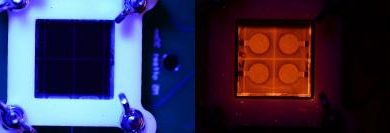Water molecules’ behavior on perovskite surfaces offers important tools for surface and materials research
Researchers at TU Wien (Vienna) explored the long-standing question of how water molecules behave when they attach to a perovskite surface, by using scanning tunneling microscopes and computer simulations. While usually only the outermost atoms at the surface are of importance, in perovskites the deeper layers are important, too. The team studied strontium ruthenate – a typical perovskite material that has a crystalline structure containing oxygen, strontium and ruthenium. When the crystal is broken apart, the outermost layer consists of only strontium and oxygen atoms; the ruthenium is located underneath, surrounded by oxygen atoms. A water molecule that lands on this surface splits into two parts: A hydrogen atom is stripped off the molecule and attaches to an oxygen atom on the crystal’s surface. This process is known as dissociation. However,…
Researchers at the University of Nebraska-Lincoln presented an innovation that could improve perovskite solar cells’ efficiency, pushing it forward on the way to rivaling silicon-based cells. The developed process increased the perovskite solar cells’ efficiency by more than 2 percentage points, to 19.4%, and the researchers also stress their hopes of achieving 25% efficiency in 3-5 years.
The process involves applying heat and a solvent to a chemical layer that transports energy absorbed by the perovskite to an electrode. Though the effects are not visible to the naked eye, this “solvent annealing” process is said to be similar to polishing a floor so that objects will move more easily across it. This process has been acknowledged by other researchers as “an important direction for further improving the efficiency of perovskite solar cells”.
Source: news.unl.edu
EfficiencyPerovskite applicationsPerovskite SolarTechnical / research
Above are Scientists develop unique annealing process that increases efficiency of perovskite solar cells web publication,Hope can help you.
Correlated Metal Films might someday replace ITO and improve perosvkite solar cells
Researchers at Pennsylvania State University have developed a transparent and electrically conductive material that could make large screen displays, smart windows, touch screens and solar cells more affordable and efficient. The material has the potential to replace indium tin oxide (ITO), the transparent conductor that is currently used for more than 90% of the display market but is expensive, scarce and brittle. Along with display technologies, the researchers will investigate the new materials with a type of solar cell that uses organic perovskite materials. The team has reported a design strategy using 10 nm-thick films of an unusual class of materials called correlated metals. In most conventional metals, such as copper, gold, aluminum or silver, electrons flow like a gas. In correlated metals, such as strontium vanadate (a perovskite material)…



